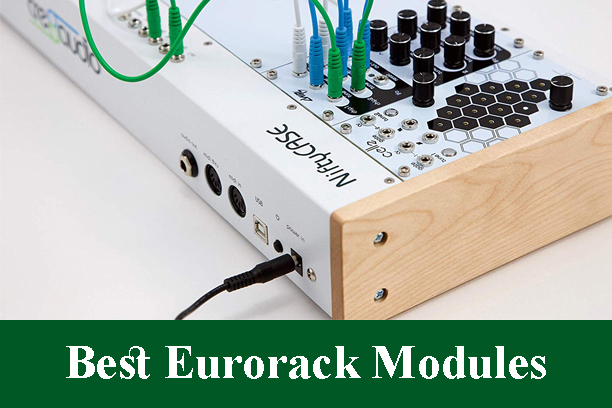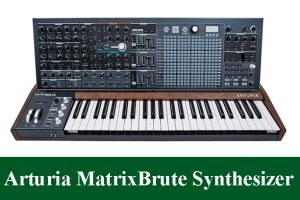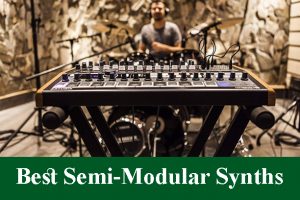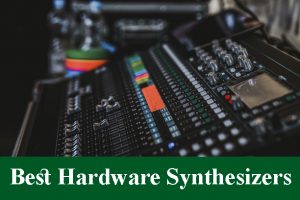Top Eurorack Modules Reviews (Updated)
The blasting universe of Eurorack can be hard to arrange, with new makers springing up constantly, and numerous versions of a similar fundamental module types.
Such a minefield can leave you distracted and wondering; which envelope to pick? Digital, or simple oscillators? What kind of channel? What number of sequencers do I need?
This guide means to give an overview of the best module in every category to assist you with assembling or extend your measured synthesizer framework. Including modules both old and new, the emphasis here is on adaptability: modules that can satisfy a few jobs in a framework or that truly consider every contingency of a given module type.
Vitally, in any case, this shouldn’t be to the detriment of ergonomics and playability. Equipment is tied in with getting hands on with your gear and playing around with your music.
3 Top Eurorack Modules
Mutable Instruments Plaits Synth Module
Width: 12HP | Depth: 25mm | Power consumption: +12V: 50mA, – 12V: 5mA
- Pros
- Little yet powerful
- Aux yield can be utilized for a stereo sign with a large number of the model types
- Dedicated CV contribution for model selection
- Cons
- Aux yield is regularly a lower signal level than the primary out
With their successor to the powerful Braids, Mutable Instruments has re-designed both equipment and programming, rearranging the interface to make Plaits progressively streamlined and playable. The eight union models for pitched sounds offer a lot of assortment: all executioner no filler! A digitally displayed low-pass entryway can be utilized to shape the sound yield as well as interior modulation of two timbre controls and FM giving you a full synth voice in only 12HP. The other eight models for clamor and percussion make this a flexible sound source that will consistently have a spot as your framework develops.
INTELLIJEL RUBICON
Width: 20HP | Depth: 38mm | Power consumption: +12V: 142mA, – 12V: 150mA
- Pros
- Octave switch
- Nine separate oscillator outputs
- Pitch compensation makes through zero FM undeniably more usable
- Cons
- A less complex oscillator might be progressively reasonable for certain clients
The Rubicon2 from Intellijel expands on it’s ancestors ability to offer likely the most flexible simple oscillator as of now available. With nine separate waveform yields, tuning by means of a 8-octave switch, hard or flip synchronize options, wave-collapsing by means of the novel Warp circuit and a limiter on the off chance that the sign gets excessively hot. Critically the through zero FM currently features a lock switch giving pitch compensation, which means no adjustment in pitch or following exactness even with the fiercest modulation. This is a simple oscillator that can truly contend with the adaptability of digital.
Analogue Solutions Eurorack Generator CV/Gate Sequencer
Width: 26HP | Depth: 42mm | Power consumption: +12V: 120mA – 12V: 80mA
- Pros
- Three sorts of sound modulation which can likewise be utilized with outer signals
- Sub-oscillator with octave switch
- Dual last yields each with their own wave folder
- Cons
- Panel format can make a few controls dubious to find a good pace
The Cš-L from Instruo expands on the exemplary Complex Dual Oscillator concept that has its birthplace in the 261e Buchla module of the ’70s and late iterations like the Make Noise DPO. What sets the Cš-L separated is the inside directing and modulation transport which introduces a large group of blend options before you even module a link. The base oscillator is a Triangle center, the top oscillator an increasingly forceful Saw center that can likewise run at LFO speeds. Not at all like most Complex Oscillators either can go about as Modulator or Primary. Once you start self-fixing the scope of tones you can coax out of this module is immense.
13 Best Eurorack Modules
Mutable Instruments Stages ASR envelope, complex 6-stage envelope, LFO, 4-step s
Width: 14HP | Depth: 25mm | Power consumption: +12V: 80mA, – 12V: 20mA
- Pros
- Unimaginably adaptable
- Straightforward interface
- CV over each stage
- Cons
- May be unreasonably intricate for amateurs
MI’s Stages is an incredibly adaptable six stage envelope generator, with CV control over each section. What’s more those six stages can be separated into six separate discharge envelopes, or anything in the middle. Going much further each stage can circle to make six synchronize capable LFOs or even a six stage pitch sequencer. A circling stage can likewise be utilized as a clock multiplier/divider or a square wave sub-oscillator for your VCO. Very flexible yet straight forward in operation, there’s continually going to be an utilization for this module in your fix.
Pittsburgh Modular Lifeforms Dynamic Impulse Filter Eurorack Variable Lowpass Gate Module
Width: 12HP | Depth: 30mm | Power consumption: +12V: 75mA – 12V: 75mA
- Pros
- An extraordinary, interesting sounding channel with an assortment of flavours
- 8-stage sine wave VCO
- 8-stage LFO
- Cons
- Knobs are stuffed in firmly
Joranalogue declare the Filter 8 as the ‘front line in secluded VCF design’. In view of the ‘work of art’ OTA 4 shaft fell low pass topology it develops with a sound all its own. The Filter8 features four separate low pass yields with varying channel inclines in addition to high pass, bandpass and indent, stage move, and standard bandpass for a genuine assortment of channel flavors. Filter8’s novel resonant input circuit empowers you to push the resonance hard without the loss of bass frequencies. Moreover when set to self-waver the module will function as an eight stage sine wave VCO with following more than 5 octaves, and in low recurrence mode as an eight yield slew modifier or an eight stage LFO.
Erica Black Quad VCA Eurorack Synth Module
Width: 12HP | Depth: 29mm | Power consumption: +12V: 65mA – 12V: 65mA
- Pros
- With four VCAs in one module you have a ton of fixing potential
- Clean sound that can be driven into distortion for more bite
- Cascade CV and Audio outs for more prominent flexibility
- Cons
- Not at this cost
The adage in Eurorack is that you can never have enough VCAs. With Intellijel’s Quad you get four completely featured VCAs in one module, giving you a lot of potential beyond basically molding the last yield level of your fix. Each VCA has flexible level control and a blend handle for straight/exponential response. Both the CV inputs and the VCA yields are fell, empowering you to utilize neighboring sets for sub blends or the entire module as a four channel blender. There is likewise a lift change to intensify feeble signals by +6db, and the sources of info misshape pleasantly when pushed hard on the off chance that you need to add a touch of nibble to your sound.
Xaoc Devices Batumi
Width: 10HP | Depth: 45mm | Power consumption: +12V:: 70mA, – 12V: 10mA
- Pros
- Tremendous recurrence extend from 28 hours up to 500 Hz
- Tap rhythm or clock input
- Expert mode firmware includes irregular LFO yields, yield scaling and more
- Cons
- Needs an expander module to get to every one of the features
The Batumi from XAOC is a completely featured quad LFO in only 10hp. Consolidating power and adaptability in a little bundle this has become the must have LFO in many racks. Each channel features 3 distinctive wave yields with the expander giving the option to change the Saw yield to three different variations. The LFOs can be utilized freely or in three modes where they are between related (quadrature/stage/isolate). They can be free running or adjusted/reset with a clock input. The optional ‘master’ firmware expands the adaptability to the detriment of the straight forward operation of the ordinary mode.
Mutable Instruments Marbles
Width: 18HP | Depth: 25mm | Power consumption: +12V: 80mA, – 12V: 20mA
- Pros
- Repeatable randomness
- Intuitive and very musical
- Built in quantisation
- Cons
- Nothing to discuss
Marbles consolidates the concept of the Turing Machine and MI’s very own Grids and Branches to give a plenty of irregular yields which can be secured in rehashing designs, with an ace beat that can be differed from unbending metronome to wild off center mood. One side of the module centers around entryways, the opposite side on smooth or ventured voltages which can be free or quantised in an assortment of ways. The middle yield gives a constantly fluctuating irregular voltage which is ideal for fixing once more into the module. While Marbles can satisfy all the standard arbitrary voltage needs it truly exceeds expectations as a wellspring of melodic and musical inspiration.
Intellijel Metropolis
Width: 34HP | Depth: 45mm | Power consumption: +12V: 195mA, – 12V: 8mA
- Pros
- Amazingly playable and extraordinary to stick with
- The two CV inputs give a lot of profundity to explore
- Cons
- Limited to 8 steps
- No design anchoring or song mode
Intellijel’s Metropolis has been around for quite a long time yet for my money it’s as yet the best Eurorack sequencer, to a great extent because of its hands on playability. eight sliders set your pitch, steps can be flipped on and off and an incredible acidic pitch twist funks things up. The most recent firmware includes tightening per step and the capacity to spare eight distinct groupings for moment review. Two assignable CV data sources can be utilized for changing parameters, for example, door length and pitch or key transposition. The Metropolis is sufficiently direct to get and stick with straight away however there’s profundity to investigate that will keep you returning.
Erica Synths Drum Sequencer Eurorack Module
Width: 42HP | Depth: 30mm | Power consumption: +12V: 152mA, – 12V: 56mA
- Pros
- Great X0X Drum machine style and playability
- CV and Gate out for a Bass Synth
- Two free running or matched up LFOs for modulation
- Cons
- Pattern connecting is fundamental, not a genuine song mode
Erica Synths Drum Sequencer professes to be the last solution for your beat sequencing needs. Pointed unequivocally at the house and techno maker with an exemplary 909-style button interface. At 42HP it’s a major module, it’s plain to see Erica Synths has settled on playability over convenientce here. However, it offers a great deal of features: with 16 yields and 14 accents for drums. A different CV and Gate for a Bass Synth, Swing, Probability, Mute/Solo and Pattern connecting, it considers every contingency of a cutting edge drum sequencer with style.
Erica Synths Fusion
Width: 16HP | Depth: 35mm | Power consumption: +12V: 70mA – 12V: 56mA
- Pros
- Extraordinary characterful sound
- Ability to spare settings with patches
- Mono or Stereo In to Stereo Out
- Cons
- The processor is somewhat delicate to include levels
The Blackhole 2 DSP is a refreshed version of Erica Synths magnificent stereo multi FX module, in view of a similar Spin FV1 chip as Tiptop’s Z-DSP. The 24 custom impacts (8 more than the first are for the most part Reverbs and Delays with Chorus/Flanger/Phaser and a couple of others tossed in. The sound is loaded with character and most likely best depicted as having a 90’s vibe. To dial in significantly more dirt the Crush control legitimately diminishes the bit-pace of the processor chip. All settings would now be able to be spared without breaking a sweat of exchanging in a live situation.
Make Noise Maths
Width: 20HP | Depth: 24mm | Power consumption: +12V: 60mA, – 12V: 50mA
- Pros
- Smart envelopes
- Really moderate LFOs
- A immense scope of utility possibilities
- Cons
- Steep expectation to absorb information might be off putting for fledglings
Maths from Make Noise is frequently portrayed as a Swiss Army blade for Eurorack. At its most fundamental it’s a couple of exceptionally smart AD voltage controlled envelopes or a couple of LFOs that will run as delayed as 26 minutes a cycle! Be that as it may, Maths is known as a function generator for a reason, the quantity of various jobs it can fill is enormous, and as a passage to getting a handle on the profundity of particular blend it can’t be beaten. Get one, and figure out how to truly utilize it.
Strymon Magneto
Width: 28HP | Depth: 41mm | Power consumption: +12V: 210mA – 12V: 210mA
- Pros
- Authentic sounding tape deferral and spring reverb emulation
- Great for hands on manipulation
- Plenty of profundity to investigate with CV control
- Cons
- Costly
Strymon’s first Eurorack module Magneto is a magnificent four head stereo tape postpone emulation. An all around designed interface makes it extraordinary enjoyable to play, while a large group of CV inputs offer bounty profundity and extension for experimentation. Postponements can run from fresh and clear to warm over-driven and warbly. The phenomenal inherent spring reverb emulation includes space and the pitch-moved postpone option implies you can likewise utilize the module as a harmony or sub bass generator. On the off chance that you drive the criticism into self oscillation you can even utilize the Magneto as a wild oscillator.
Qu-Bit Chord v2 Polyphonic Oscillator Eurorack Synth Module
Width: 10HP | Depth: 37mm | Power consumption: +12V: 35mA, – 12V: 30mA
- Pros
- Sounds amazing
- Swappable diodes for various distortion flavours
- Feedback in/out grows the sonic possibilities
- Cons
- None to discuss
Custom Electronics first module Miasma is a voltage controlled Distortion. The enormous and very squirm well disposed Feedback handle tells you what this module is about. With the criticism transformed up you can undoubtedly drive the module into self-oscillation even without an info signal. This input way can be opened and the sign bolstered through other impact modules colossally growing the sound design conceivable outcomes. The tone of Miasma is additionally modifiable at the equipment level. The two rectification diodes (one for every extremity of the sign) are available at the rear of the module and it accompanies an assortment of additional items so you can swap them around to differ the tone from warm fluff to Industrial distortion. An expander will be accessible in the blink of an eye so you can change diodes with a switch.
Mutable Instruments Yarns Midi to CV Interface and Sequencer Arpeggiator Eurorack Synth Module
Width: 8HP | Depth: 32mm | Power consumption: +12V: 50mA, – 12V: 1mA
- Pros
- An abundance of modulation potential outcomes adjusted to clock
- Expanders offer additional connections for outer apparatus (MIDI and Din sync)
- Settings can be spared in up to 200 slots
- Cons
- Menu jumping and single encoder make navigation marginally challenging
The new version of Pam’s Workout from ALM takes the concept of Clock modulation and extends it in a wide range of synchronize capable circle capable directions. It’s center clock is unshakable and it’ll connect to all your distinctive studio gear so it’s ideal as an ace clock. Every one of it’s 8 yields can be adapted, stage moved, deferred and swung. Euclidean or likelihood based advance skipping can be utilized for beat creation. The wave yield can likewise be changed to give you an entire host of matched up LFOs. Pam’s New Workout offers an enormous exhibit of modulation probability in a little bundle. It’s capacity is sufficient to legitimize it a spot here as the only module in the rundown with a screen and menu framework.
Tiptop Audio ONE Eurorack Sample Player Module
Width: 4HP | Depth: 43mm | Power consumption: +12V: 80mA, – 12V: 8mA
- Pros
- Low latency
- Great sound quality
- Compact size
- Cons
- Switching between tests on the fly presents dormancy issues
The One from Tiptop Audio offers very low idleness test playback from a miniaturized scale SD card, making it perfect for drum and percussion tests. For pitch based material it features an implicit quantizer option with a scope of scales. The CV information can likewise be utilized to switch between various examples on the fly to widen your sound palette. Sadly this will build the inertness so it’s not so much reasonable for drum tests. The module is likewise DC coupled so you can likewise utilize it to yield control voltage: playing back examples of LFOs, envelopes or arbitrary voltages. The One accompanies 60 sounds included, with other example cards accessible from Tiptop, or you can make your very own obviously.




















